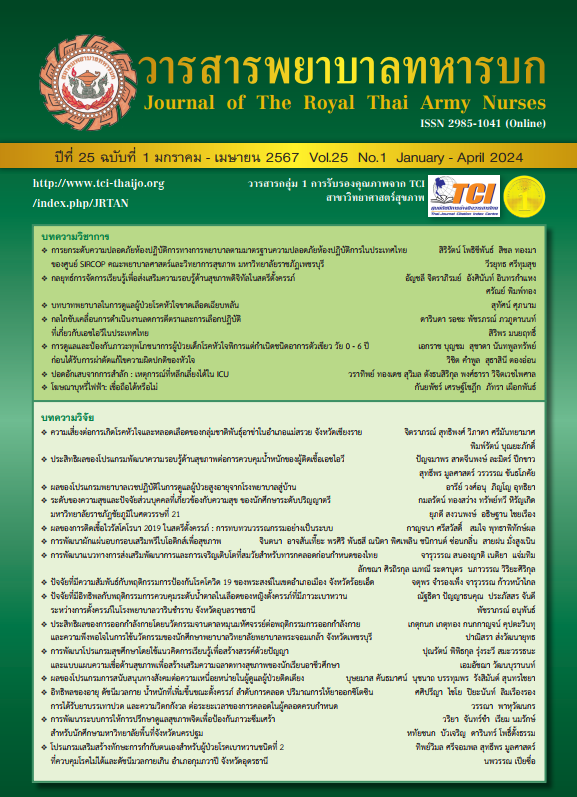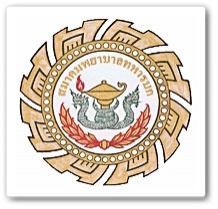The Factors Related to COVID-19 Preventive Behaviors among Buddhist Monks in Muang District, Roi-Et
Keywords:
Buddhist monks, preventive behavior, COVID-19Abstract
This research aimed to study the preventive behavior against COVID-19 and its related factors among Buddhist Monks. A multi-stage sampling process yielded 120 monks. The instrument included questionnaires for sociodemographic, perceived susceptibility, perceived severity, perceived barriers, perceived benefits, perceived self-efficacy, and preventive behavior against COVID-19. The data were analyzed using descriptive statistics, Pearson Product-Moment Correlation, and Point Biserial Correlation. The results revealed that the samples had a high level of preventive behaviors against COVID-19 (M = 85.88, S.D.=10.29). The behaviors related significantly (p < .01) with perceived self-efficacy (r = .415), perceived benefits (r = .414), perceived susceptibility (r = .403), and perceived severity (r = .227)
Downloads
References
World Health Organization. Coronavirus disease 2019 (COVID-19) situation report. World Health Organization; 2020.
Bruminhent J, Ruangsubvilai N, Nabhindhakara J, Ingsathi A, Kiertiburanakul S. Clinical characteristics and risk factors for coronavirus disease 2019 (COVID-19) among patients under investigation in Thailand. Public Library of Science ONE. 2020;15(9):1-14. (in Thai)
Potranan T, Kasipol T, Prasertson C. Variables Associated with Self-Care Capacity within the Framework of Good Health Components among Monks in Dusit District, Bangkok. Kasem Bundit Journal. 2017;18(1):135-45. (in Thai)
Wuttisaksakul K, Factors Related to Health Behaviors of Monks in Fang District, Chiangmai. Journal of Nurses Association of Thailand Northern Region. 2018;24(1):71-83. (in Thai)
Lasutham K, Siripitayakunkit A, Panpakdee O. Factors Related to Self-Care Behavior of Thai Buddhist Monk with Coronary Artery Disease. Ramathibodi Nursing Journal. 2018; 24(3):313-27. (in Thai)
Sukrueangkul A, Vannarit T, Boonsoi P, Autsri P. Factors Predicting Health Promotion Behaviors among Buddhist Monks in Chiang Raised Province. Nursing Journal. 2017;44(2):38-48. (in Thai)
Leeyutthanont M, Uraiwan P, Kaewsakulthong J, Saetew P. Development of Health Education Model for Monks. The Journal of Baromarajonani College of Nursing, Nakhonratchasima. 2019;25(2):104-17. (in Thai)
Mheeaium P, Kanokthet T. Factors Effect with Health Behaviors of Monk in Takhli District, Nakhonsawan Province. Nakhon Lampang Buddhist’s Journal. 2020;9(3):1-12. (in Thai)
Mahmood K, Fatemeh B, Robards S, Akbar B. H, Naser H, Amir H. P, et al. Factors related to preventive COVID-19 behaviors using Health Belief model among general population: a cross-sectional study in Iran. Biomedcentral Public Health. 2021;21(1):1934. doi:10.1186/ s12889-021-11983-3.
Shahnazi H, Ahmadi-Livani M, Pahlavanzadeh B, Rajabi A, Hamrah M, Charkazi A. Assessing preventive health behaviors from COVID-19: a cross sectional study with health belief model in Golestan Province, Northern Iran. Infectious diseases of poverty. 2020;9(1):157. doi:10.1186/s40249-020-00776-2.
Tadesse T, Alemu T, Amogne G, Endazenew G, Mamo E. Predictors of coronavirus disease 2019 (COVID-19) prevention practices using health belief model among employees in Addis Ababa, Ethiopia. 2020. Infection and Drug Resistance. 2020;13:3751-61.
Kim S, Kim S. Analysis of the Impact of Health Belief and Resource Factors on Preventive Behaviors against the COVID-19 Pandemic. International Journal Environmental Research and Public Health. 2020;17(22):8666. doi:10.3390/ijerph1722866.
Rosenstock I. M., Strecher V. J., Becker M. H.. Social Learning Theory and the Health Belief Model. Health Education Quarterly. 1988;15(2):175-83.
Meenongwah J, Promwong W, Thammathorn P, Siriwatthano S, Tabaselo S. P, Kosonwiharakol P. Health Belief Model and Disease Prevention Behaviors on Coronavirus Disease (COVID-19) among monks in Ubon Ratchathani Province. Journal of MCU Ubon Review. 2022;7(1): 817-32. (in Thai)
Phonpinyo M, Phajan T, Vonok L. Factors Associated with Preventive Behaviors for Coronavirus 2019 (COVID-19) of Monks and Novices in Chum Phae District, Khon Kaen Province. Regional Health Promotion Center 9 Journal. 2023;17(3):827-41. (in Thai)
Wuttisaksakul K. Factors Related to Health Behaviors of Monks in Fang District, Chiangmai. Journal of Nurses Association of Thailand Northern Region. 2018;24(1):71-83. (in Thai)
Kasaro K, Noonkium D, Chimhad P. The Behaviors in Taking Care of Health Possessed by The Monks in Prasong Sub–District Thachana District Suratthani Province. Journal of MCU Nakhondhat. 2021;8(5):231-47. (in Thai)
Zewdie A, Mose A, Sahle T, Bedewi J, Gashu M, Kebede N, Yimer A. The health belief model’s ability to predict COVID-19 preventive behavior: A systematic review. SAGE Open Medicine. 2022;10:20503121221113668. doi: 10.1177/20503121221113668.
Affendi I, Nor Asiah M, Norma M, Mohd Hatta A, Noor Aliza L, Sabtuah M, et al. Association between self-efficacy and health behaviors in disease control: A systematic review. Global Journal of Health Science. 2018;10(1):1-18.
Fathian-Dastgerdi Z, Khoshgoftar M, Tavakoli B, Jaleel M. Factors associated with preventive behaviors of COVID-19 among adolescents: Applying the health belief model. Research in Social and Administrative Pharmacy. 2021; 17(10):1786-90.
Chen Y, Zhou R, Chen B, Chen H, Li Y, Chen Z, et al. Knowledge, Perceived Belief, and Preventive Behavioral Related to COVID-19 Among Chinese Older Adult: Cross-Sectional Web-Based Survey. Journal of Medicine Internet Research. 2020;22(12):e23729.
Chen H, Li X, Gao J, Liu X, Mao Y, Wang R, et al. Health Belief Model Perspective on the Control of COVID-19 Vaccine Hesitancy and the Promotion of Vaccination in China: Web-Based Cross-sectional Study. Journal of Medical Internet Research. 2021;23(9):e29329.
Hinkong W, Thongbai W, Kummabutr J. The Factors Predicting Cardiovascular Disease Preventive Behaviors Among Monks in Sisaket Province in Thailand. Journal of Social Science and Buddhistic Anthropology. 2022;17(4):396-11. (in Thai)
Junwin B, Yok-in J, Tengrothnapaporn P, Dissara W. Factors related to self-protection behaviors from COVID-19 of the people in the dark red area, Nakhon Si Thammarat province. Journal of Council of Community Public Health. 2022;4(1):1-14. (in Thai)
Trairatnopas V, Aree P, Phimchaisai P. The Benefit and Barriers, and Health Behaviors toward Preventing the Spread of Coronavirus in Elderly. Journal of The Royal Thai Army Nurses. 2021;22(3):105-12. (in Thai)
Rojpaisarnkit K, Kaewpan W, Pengpid S, Peltzer K. COVID-19 Preventive Behaviors and Influencing Factors in the Thai Population: A Web-Based Survey. Frontiers in Public Health. 2022;10: 816464. doi:10.3389/fpubh.2022.816464.
Badr H, Oluyomi A, Woodard L, Zhang X, Raza S, Fahmideh M, EI-Mubasher O, Amos C. Sociodemographic and Health Belief Model Factors Associated with Nonadherence to COVID-19 Mitigation Strategies in the United States. Annals of Behavioral Medicine. 2021;55(7):677-85.
Artsanthia J, Pitplearn N, Prachyakoon N. Direction of Health Care in Pandemic of Corona Virus 2019 in New Normal of Community Nurse. Journal of The Royal Thai Army Nurses. 2022;23(1):57-64. (in Thai)
Downloads
Published
How to Cite
Issue
Section
License
Copyright (c) 2024 Journal of The Royal Thai Army Nurses

This work is licensed under a Creative Commons Attribution-NonCommercial-NoDerivatives 4.0 International License.
บทความหรือข้อคิดเห็นใดใดที่ปรากฏในวารสารพยาบาลทหารบกเป็นวรรณกรรมของผู้เขียน ซึ่งบรรณาธิการหรือสมาคมพยาบาลทหารบก ไม่จำเป็นต้องเห็นด้วย
บทความที่ได้รับการตีพิมพ์เป็นลิขสิทธิ์ของวารสารพยาบาลทหารบก
The ideas and opinions expressed in the Journal of The Royal Thai Army Nurses are those of the authors and not necessarily those
of the editor or Royal Thai Army Nurses Association.





